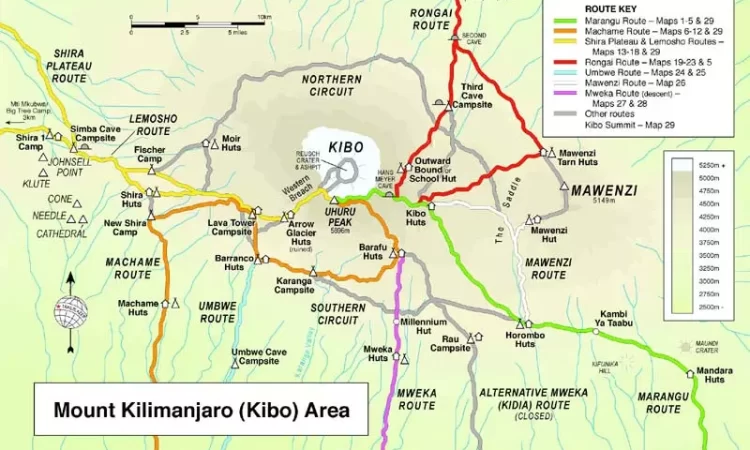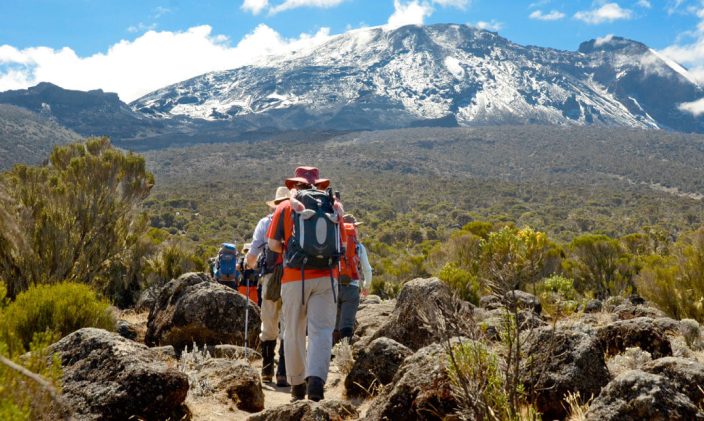Kilimanjaro Trekking Routes

For hikers heading to Africa, trekking the Kilimanjaro is the next thing they’re up for. And it’s worth it, not just for the thrill, but because it’s the continent’s highest peak. With its peak at 5,895 meters (19,341 ft) above sea level, Kilimanjaro rises taller than any other freestanding mountain in the world. And when compared to the other world’s seven summits, Kilimanjaro tops the list as the easiest mountain to hike. So, yes, everyone can hike it.
While some large mountains have a few hiking routes, Kilimanjaro has seven well-established paths up the mountain. These trails take hikers to the snow-capped peak of Kibo, each offering a unique experience, scenery, difficulty, and success rates. In this guide, we walk you through the seven trekking routes of Mount Kilimanjaro. Let’s start the journey!
Marangu Route.
Also called the ‘Coca-Cola’ route, this is the oldest, well-established route on Mount Kilimanjaro. It’s the best route for beginners. What makes it beginner-friendly is its gentle slope and the best accommodation. The route has huts, which many first-time climbers prefer over camping.
The total distance of the Marangu route is 72 km (45 miles), round-trip, and it takes 5 days of hiking to beat Kilimanjaro. Despite being short and gentle, this route has a low success rate of about 60-70%. You may be wondering what causes the low success rate on this easier-to-climb route. Here’s a thing:
- The more days you spend on the mountain, the higher the chances of success.
Which means: if you choose to trek for just 5 days, you’re more likely to fail. Your success rate is below 60% because you don’t allow enough time to acclimate. But if you extend a day to make it a 6-day climb, you increase your chances of summiting this spectacular mountain.
Pro tip: Choose a 6-day or 7-day climb to increase the success rate when it’s your first exposure to higher altitudes.
Machame Route.
Dubbed as the ‘Whiskey route,’ this is the second famous route on Kilimanjaro. We also recommend it for beginners, but it’s a bit tougher than the Marangu route. The route covers 62 kilometers (37 miles) round-trip, taking you through the ridges and valleys. For that reason, the Machame route takes longer to complete than the Marangu route. The average hike takes 6 days, but for acclimatization, we recommend a 7-day climb.
The route is more scenic and has no huts. So, here, you’ll experience a more rustic experience as you negotiate your way up. What makes it challenging is the Barranco Wall, a cliff, which challenges beginners and makes hiking more difficult. But our support team will be there to assist you with the daypack and tips to succeed. Its success rates range from 85-90% depending on how many days you’ll spend in the mountains.
Pro tip: Machame is great if you want a slightly challenging hike. Seasoned climbers usually love it.
Rongai Route.
If you want to ascend Kilimanjaro from the north, then this is your route. It starts in the north near the Kenyan border and goes up the mountain, then merges with the Marangu route. The descent is through the Marangu route.
This route is also good for first-time hikers as it has a gentle slope. On top of that, it’s more scenic and usually quiet, unlike most western routes. You need just 6-7 days of hiking to conquer Kilimanjaro through this route, and the success rates range between 70% to 80%.
Pro tip: The Rongai route is perfect for hiking in the rainy season because the north part of Mount Kilimanjaro receives a little rainfall compared to the west.
Northern Circuit Route.
This is the newest and longest Kilimanjaro trekking route. The route takes you through an untouched trail up Kilimanjaro, giving you the chance to enjoy photo opportunities along the way. Northern Circuit routes take 8 to 11 days to complete, but the reward is a sure thing. With 98% success rates, this is the most successful Kilimanjaro climbing route. However, you should take it if you’re ready for the hustle and bustle along the way.
Pro tip: This route requires physical strength and more porters to assist you. So, it can be expensive than any other route.
Lemosho Route.
If you want to view the natural beauty of Mount Kilimanjaro, hike this route. It takes its way from the west, but unlike other western routes, it’s less crowded. Lemosho offers wildlife encounters in the lower rainforest zone. You might be lucky to see antelopes, monkeys, and birds.
The hiking takes 7-8 days and goes up to the Lava Tower, where it merges with the Machame. From there, you can join other trekkers. It’s good for intermediate hikers because there are still steeper portions, which may be quite challenging for beginners.
Pro tip: The Lemosho route offers unique photography opportunities, offering you a two-in-one experience: hiking and photography.
Umbwe Route.
We can say this is the most direct route on Mount Kilimanjaro. It has a steep inclination, which makes it difficult to hike. The route takes just 5 days to complete, but just for experienced hikers. We don’t recommend it for beginners. And if you choose it, spend 6-7 days hiking to increase your success rate. Otherwise, it will fail you.

Pro tip: We encourage seasoned hikers to test their climbing skills and fitness on this route. It’s a tough hike worth the challenge.
Shira Route.
This is another remote route up Kilimanjaro. It ascends Mount Kilimanjaro via the Shira Plateau, one of the highest plateaus on Earth, offering you the chance to view one of the three volcanic cones of Kilimanjaro. The Shira route takes 6 days of hiking to complete.
Pro tip: This route is good if you want to see Shira Plateau, a dead volcanic cone on Mount Kilimanjaro. The route requires endurance.
The bottom line.
Climbing Kilimanjaro is a special treat even if you make it once in a lifetime. Also, no two hikes are the same on this dormant volcano. We are here to help you reach the “roof of Africa.” Our safari planners are here to help you achieve your dream of reaching Africa’s highest peak. Please contact us.


